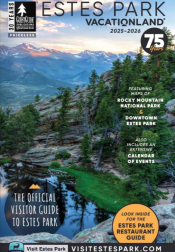Why Winter in Rocky Mountain National Park is Magical
As Rocky Mountain National Park’s Management Specialist/Public Affairs Officer, Kyle Patterson is one of the lucky few. She gets to witness the diversity that each season brings to this magical natural landscape, from January to December every year. Winter, when a serene calm descends on the Park, is a particular favorite. The crowds thin out (especially on weekdays), and there are a myriad of unique experiences to discover – along with more than a few surprises.
“The three main reasons that people have been coming to RMNP for decades are still very much available in the winter,” Kyle says. “There’s scenic grandeur everywhere you look, of course – snowcapped peaks and blue skies. There’s watchable wildlife. And there are a lot of recreational opportunities. You just experience the Park differently in the winter.”
Winter’s Wild Side
What kind of winter wildlife can you see in RMNP? The season is an especially good time to look for elk, mule deer, coyotes and other large mammals. It just so happens that elk love colder weather – 26 degrees Fahrenheit is their sweet spot.
“Some species are easier to see in winter, because they can be active during the day,” Kyle says. “The elk often come down to lower elevations during the winter.”
There are also some raptor species that stay in the Park year-round, so you might see red-tailed hawks or great-horned owls, along with other birds like Steller's jays (look for their brilliant blue bodies and crested heads), gray jays, Clark’s nutcrackers and long-tailed black-billed magpies. Kyle’s top picks for places to get a glimpse of winter’s wild side are the open meadows in RMNP – Moraine Park, Upper Beaver Meadows and Horseshoe Park among them.
“RMNP is a known as a hiker’s park, with over 350 miles of trails,” Kyle says. “Sometimes people are surprised that wintertime here still offers great opportunities to stay active and get outside.”
Upper Beaver Meadows Road and Old Fall River Road are closed to vehicles in the winter and those are both great winter hikes, which, depending on conditions, can often be hiked in standard hiking boots. As the park transitions into slightly more snowy weather, hikers can use traction devices like YakTrax on their shoes. And of course, when the snow really starts to fall, RMNP becomes a snowshoe enthusiast’s paradise. If you’ve never snowshoed before, no worries – if you can hike, you can snowshoe.
RMNP even offers ranger-led snowshoeing programs. “They fill up really quickly – they’re very popular,” Kyle reveals. “Most people who try it out get comfortable with the equipment and find that it’s not too much of a jump from hiking. It’s very similar and easy to learn – and it opens up this whole new world.” The most popular areas to snowshoe are in the Bear Lake trail network, she says. There are a number of locations along the Bear Lake Road corridor, including trailheads leading from Bear Lake or Glacier Gorge or Bierstadt or the Glacier Basin Campground area. Wild Basin and Hidden Valley are other good areas.
Don’t be too concerned about the cold, either. Snowshoeing is an active experience and once you get going, you’ll warm up in no time.
Hidden Valley
The hub of winter fun in Rocky Mountain National Park is Hidden Valley, a former ski area located off Trail Ridge Road just below and west of Many Parks Curve. For one thing, it’s the only place where you can sled (or tube) in the Park. “It’s not meant to be an ‘extreme sledding’ situation – but it can be really fun!” Kyle says. “You can go pretty fast. Some people will even snowshoe up the slopes and snowboard back down.” Good to know: at the base of Hidden Valley, there are heated flush restroom facilities daily and on weekends, a warming hut. In short, it’s the perfect place for family snow play. Hidden Valley is also home to a new avalanche beacon park, which is designed for backcountry enthusiasts to practice simulated avalanche searches using their own beacons/transceivers and probes.
Kyle’s Winter Safety Tips
- Always be prepared for the possibility of snow and freezing temperatures. Bring the right gear to keep you warm.
- Be aware of short winter daylight hours. Glorious mountains surround the Park, but that means it’s in a bowl and it can get darker quicker.
- Don’t depend on your cell phone. There are a lot of places in the Park that don’t have cell phone coverage … and in cold weather, batteries can sometimes freeze!
- Bring a topographic map or have a GPS system. Many trails are not marked for winter use, so you might not recognize spots in the winter, even if you’ve been on the same trail in the summer.




